Several of the world’s free nations will greet the year 2022 under the immediate threat of conquest by authoritarian forces, either through military invasion or subversion from within.
The best-known example is Taiwan, an outpost of free-market democracy under the perpetual threat of conquest by the hideous tyrants of China.
China ramped up its campaign of diplomatic isolation and intimidation against Taiwan after the election of President Tsai Ing-wen in 2016. Outside observers saw Tsai’s landslide re-election in 2020 as a rebuke of these tactics. China ignored the rebuke and redoubled its efforts.
In 2021, China dramatically escalated its campaign of physical intimidation by sending warplanes into Taiwan’s Air Defense Identification Zone (ADIZ), including a record 52 incursions in a single weekend in October.
According to the Taiwanese Defense Ministry, there were 554 incursions between September 2020 and August 2021. Beijing’s campaign of intimidation intensified after Taiwan applied to join the CPTPP, a regional trade agreement China also aspires to join (and dominate).
These “gray zone” tactics are intended to both terrorize the Taiwanese people and exhaust their defense forces, as the much smaller Taiwanese air force is obliged to keep scrambling fighters to counter each Chinese act of aggression.
Last week, the Taiwanese Defense Ministry said it fears China could turn large-scale military exercises near Taiwan into a full-scale surprise attack, while simultaneously deploying naval forces to keep allies like the United States and Japan from coming to Taiwan’s assistance. Chinese officials and state media are increasingly belligerent about threatening to attack any military that attempts to defend Taiwan, including the U.S. military.
Taiwan believes China will be capable of staging such an overwhelming invasion, with “cost and attrition” acceptable to Chinese Communist Party leaders, by 2025.
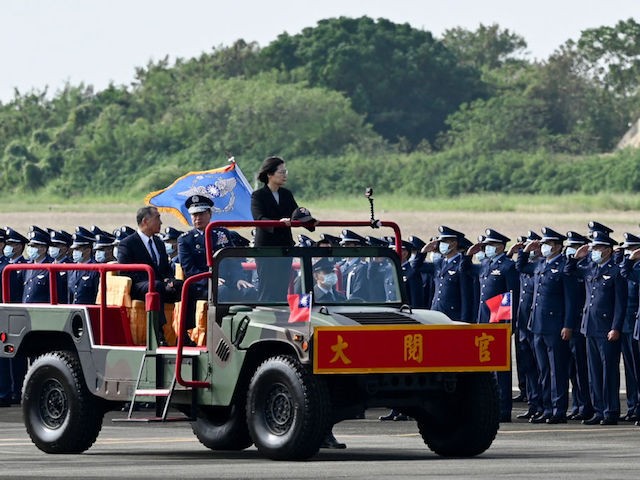
Taiwan President Tsai Ing-wen (C) inspects air force troops during a ceremony at the Chiayi Air Force in southern Taiwan on November 18, 2021. (SAM YEH/AFP via Getty Images)
“Chinese control of Taiwan would dramatically reinforce the Communist Party’s prestige at home and eliminate the island as a viable model of a democratic alternative to authoritarian Party rule. It would also give China a foothold in the so-called first island chain, the line which runs through the string of islands from the Japanese archipelago to Taiwan, the Philippines and Borneo, which enclose China’s coastal seas,” Reuters noted when running through a list of possible invasion scenarios in November.
Some of those scenarios envision China provoking a conflict by getting carried away with “gray zone” tactics and refusing to back down, or by moving to take some of Taiwan’s outlying islands and underestimating the resolve of Taiwanese forces to defend them. Many analysts believe Chinese dictator Xi Jinping is resolved to grab Taiwan before he dies, retires, or loses power.
Seizing Taiwan may appeal to Chinese leaders as a bold move that would destroy the credibility of the United States and Europe, frightening other Asian powers into China’s orbit because they can no longer rely on Western security guarantees. The death of democracy in Taiwan could threaten its survival in South Korea, Japan, the Philippines, and elsewhere.
Conversely, the more reassuring analysts believe China will not progress beyond “gray zone” intimidation tactics to a full-blown invasion of Taiwan because even with China’s growing military power, it still could not hope to seize the formidable island by force without suffering horrific casualties, potentially breaking the Communist Party’s grip on domestic power and uniting the rest of the world into opposition.
And then again, democracy could conceivably topple in Taiwan without a military invasion. China invested considerable effort in subverting Taiwanese democracy and nourishing pro-Beijing opposition parties before Tsai’s re-election infuriated Beijing; it is possible China could resume those patient efforts at destabilization, eventually cooking up a Taiwanese government more amenable to “peaceful reunification.”
“The long-term military threats to Taiwan are increasing, but the more immediate threats are actions taken by China that fall into the realm of hybrid warfare and political warfare aimed at subverting institutions and eroding the psychological resiliency of the people of Taiwan,” Global Taiwan Institute executive director Russell Hsaio told the Washington Post on Sunday.
Also living under the threat of invasion from the authoritarians next door is Ukraine. Russia now has over 90,000 troops massed along the Ukrainian border and Ukrainian intelligence believes they could invade by the end of January 2022.
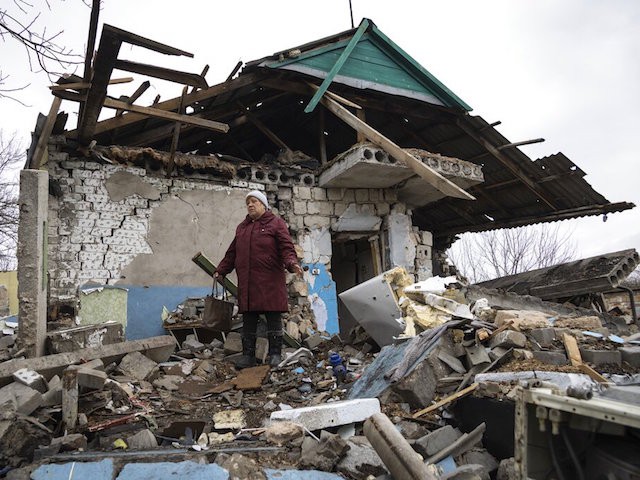
Liudmyla Momot weeps as she searches for any still-usable items Friday, Dec. 10, 2021, in the debris of her house in the village of Nevelske in eastern Ukraine, that was struck by a mortar shell fired by Russia-backed separatists. (AP Photo/Andriy Dubchak)
There was no sign of Russian de-escalation in the last few days before Christmas, no slowdown in Russia’s military buildup after President Joe Biden told Russian leader Vladimir Putin he would pay a “terrible price” for invading Ukraine. Putin responded to Biden’s threat by moving another motorized infantry unit to the border. Military analysts noted Russian troops coming from as far away as Siberia and Mongolia to join the buildup.
Russia continues to send menacing signals that it will make a move on Ukraine, such as ostentatiously posting new regulations this week that make it easier to bury casualties from military conflicts in mass graves. Relentless Russian propaganda portrays the Ukrainian government as an illegitimate puppet of foreign interests.
In early December, Putin described Ukraine’s battle against Russia-backed separatists in the eastern Donbas region as “genocide” and “Russophobia,” playing up the threat to ethnic Russians that would be used as a pretext for invasion.
The U.S. and U.K. have quietly dispatched cybersecurity experts to Ukraine to help it brace for expected Russian hacking attacks on its critical infrastructure, from the power grid to the banking system.
Some analysts anticipate a wave of cyberattacks in conjunction with a physical invasion, to paralyze the Ukrainian government, while others think cyberattacks would precede the invasion and become part of Russia’s propaganda campaign, to create the impression that Ukraine’s government is incompetent and illegitimate.
The most hopeful tangible sign that Putin will use these troops for intimidation, rather than invasion, is the apparent lack of logistical networks and supplies, including fuel and munitions, that would be needed for a major invasion. Some strategists believe Russia has still only massed a little over half the troops needed for all-out war in Ukraine, especially if Putin envisions a lightning campaign that would overwhelm and dislodge the government in Kyiv before Western nations could intervene.
Putin’s rhetoric has lately turned toward complaining about the threat NATO supposedly presents to Russian security by “aggressively” expanding into eastern Europe, which could be a sign that his buildup on the Ukrainian border is largely theatrical, an attempt to look tough and squeeze strategic concessions out of the U.S. and Europe. In this best-case scenario, Putin effectively settles for promises from NATO that it will not offer membership to Ukraine; in the worst-case, he intends to use that “threat” from NATO as an excuse to invade.
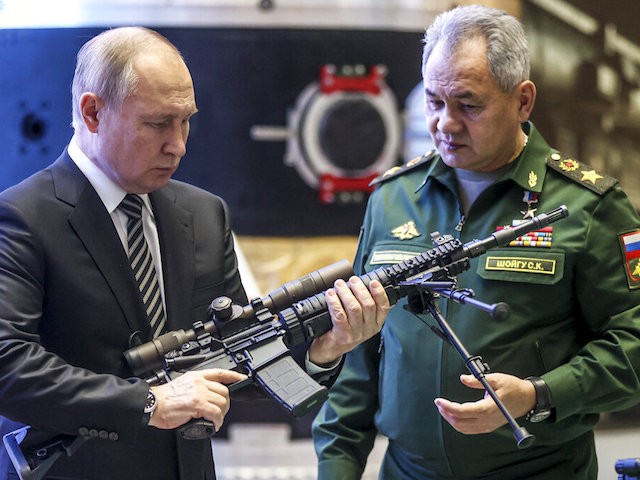
Russian President Vladimir Putin, left, and Russian Defense Minister Sergei Shoigu visit a military exhibition after attending an extended meeting of the Russian Defense Ministry Board at the National Defense Control Center in Moscow, Russia, Tuesday, Dec. 21, 2021. (Mikhail Metzel, Sputnik, Kremlin Pool Photo via AP)
Another theory is that Putin will settle for some territorial concessions from Ukraine, possibly taking control of the eastern Donbas region through either outright annexation or a new “security arrangement” that effectively pushes the border westward by stationing Russian “peacekeeper” forces on what is now Ukrainian ground. Politicians from Putin’s party have publicly declared this as an objective.
In the least troubling of all scenarios, Putin’s buildup on the Ukrainian border is pure theater meant for public consumption – posturing and a demonstration of strength on the 30th anniversary of the Soviet Union’s collapse.
Putin commemorated the anniversary by describing the fall of the Soviet empire as the disastrous end of “historical Russia,” making the loss of the Soviet satellite states a crime against Russian sovereignty. In the best of all possible worlds, he is shuffling troops around the Ukrainian border as a nostalgia exercise to shore up support with hardline Russian nationalists and Soviet nostalgics, a massive live-action role-playing game.
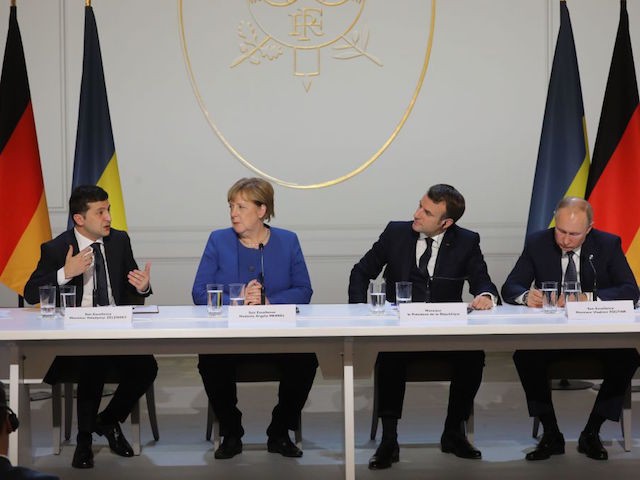
Ukrainian President Volodymyr Zelensky, German Chancellor Angela Merkel, French President Emmanuel Macron and Russian President Vladimir Putin give a press conference after a summit on Ukraine at the Elysee Palace, in Paris, on December 9, 2019. (LUDOVIC MARIN/POOL/AFP via Getty Images)
Many of these outcomes that come short of full-scale invasion would still damage democracy in Ukraine, especially if the crisis ends with Russia gobbling up Ukrainian territory. As can be seen from the above-quoted statements, Putin wants to demonstrate that Ukraine’s democracy is illegitimate, corrupt, and incapable of properly addressing the needs of a multi-ethnic population.
In South America, there are troubling signs of anti-democratic leftist dictatorships on the rise. The odious regime of Nicolás Maduro appears securely in control of Venezuela, having vanquished a pro-democracy movement even as the national economy comes crashing down in socialist flames.
International observers are nervously hoping the new leftist president of Chile, Gabriel Boric, does not follow in Maduro’s footsteps. Boric claims his policies will be modeled on European welfare states, but the Chilean opposition sees echoes of the early days of Maduro and his mentor, Hugo Chávez.
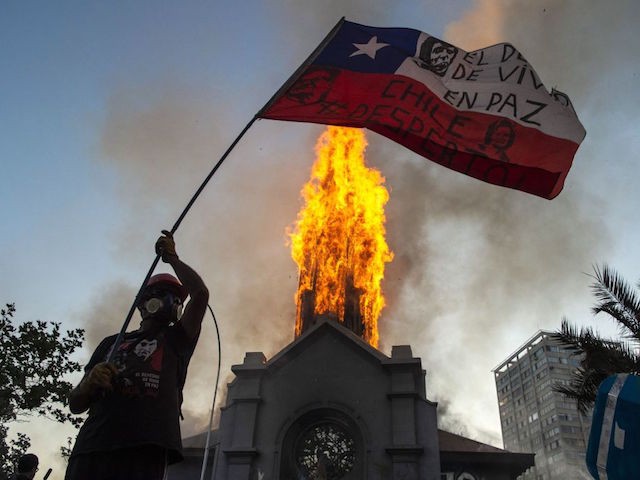
A demonstrator flutters a Chilean flag outside the burning church of Asuncion, set on fire by protesters, on the commemoration of the first anniversary of the social uprising in Chile, in Santiago, on October 18, 2020, as the country prepares for a landmark referendum. (MARTIN BERNETTI/AFP via Getty Images)
Boric’s defenders say allegations of communist leanings were just an election smear campaign against Boric; the Chilean stock market appears to be holding its breath and hoping that’s true. The Communist Party of Chile was part of the coalition supporting Boric and he did not condemn their support.
Authoritarian powers like China and Iran are increasing their influence in Latin America, posing both a strategic challenge to the United States and an ideological threat to democracy. Latin American dictators are already skilled at mimicking the forms of democracy, such as holding sham elections, while draining its essence. China, which just held the mother of all sham elections in Hong Kong, can help them polish their skills even further.
Democracy in other parts of the developing world is threatened by a string of military coups. The most horrific example is obviously Afghanistan, where the Taliban insurgency swept away the elected civilian government in a matter of days while the Biden administration fumbled through a disastrous withdrawal of American troops.
Thanks to Biden’s reckless abandonment of American military equipment and weapons, the Taliban is now the best-armed junta in the world, with plenty of munitions to spare for sale to other anti-democratic forces.
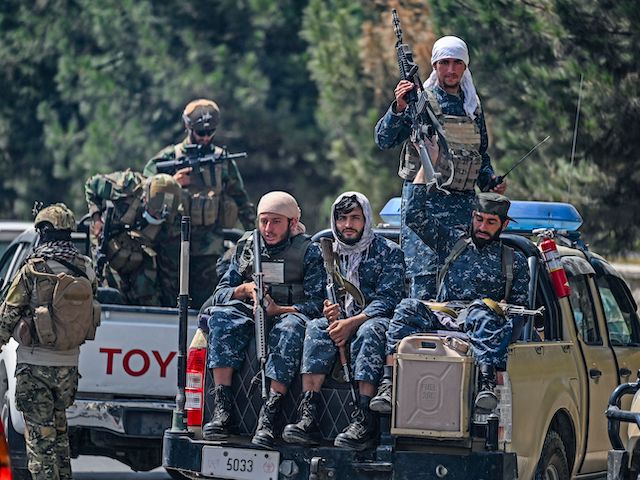
Taliban fighters patrol along a street in Kabul on August 29, 2021, as suicide bomb threats hung over the final phase of the US military’s airlift operation from Kabul, with President Joe Biden warning another attack was highly likely before the evacuations end. (AAMIR QURESHI/AFP via Getty Images)
In Myanmar and Sudan, military juntas seized power after losing patients with the elected civilian halves of their “fusion” or “transitional” governments. These juntas have survived intense pressure from human rights activists, democratic governments, and the United Nations.
Libya, transformed into a gruesome wasteland of warlords and jihadis by Biden’s Democrat predecessor Barack Obama and his Secretary of State Hillary Clinton, is still struggling to hold a nationwide democratic election. Ten years after Obama’s invasion, Libya perpetually teeters on the edge of either disintegrating completely or becoming a military dictatorship.
If Libya does manage to hold an election soon, one of the leading candidates would be the aspiring military dictator, Khalifa Haftar, who came close to toppling the internationally-recognized government and installing a junta just a few years ago.
2022 will dawn with democracy in peril – not just from the vicious struggle to redefine it being waged across the Western world, but from numerous fragile democracies on the brink of external invasion or authoritarian revolution. 2021 was the year that saw freedom and autonomy die in Hong Kong. Representative government is on the chopping block in far too many other places.

COMMENTS
Please let us know if you're having issues with commenting.